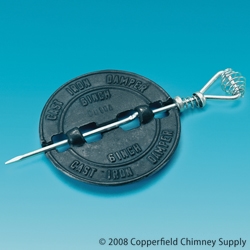
Stove pipe dampers play a crucial role in regulating airflow and optimizing the efficiency of your stove. However, like any mechanical component, they can encounter issues that affect performance. In this guide, we’ll explore 10 common problems with stove pipe dampers and provide practical solutions to address them.
1. Stiff or Difficult to Operate:
Problem: The damper becomes stiff, making it challenging to open or close.
Solution: Apply a high-temperature lubricant to the hinge and moving parts. This will ease operation and prevent stiffness.
2. Damper Won’t Close Completely:
Problem: The damper fails to close fully, allowing excess air to enter the stove.
Solution: Inspect for debris or soot buildup preventing a complete closure. Clean the damper and surrounding areas thoroughly.
3. Damper Won’t Open Fully:
Problem: The damper does not open entirely, restricting airflow and reducing stove efficiency.
Solution: Check for obstructions or buildup hindering the damper’s movement. Clean and lubricate as needed.
4. Rust and Corrosion:
Problem: Rust and corrosion can develop on the damper, affecting its structural integrity.
Solution: Remove rust using a wire brush, and apply a high-temperature paint or rust-resistant coating to protect against future corrosion.
5. Damaged or Warped Damper Plate:
Problem: The damper plate may become damaged or warped over time, hindering its proper functioning.
Solution: Replace the damaged damper plate with a new one to restore optimal performance.
6. Noisy Operation:
Problem: Unusual noises, such as rattling or clanking, occur during damper operation.
Solution: Tighten loose components and inspect for any foreign objects caught in the damper. Lubricate moving parts to reduce friction and noise.
7. Damper Shaft Misalignment:
Problem: The damper shaft may become misaligned, affecting its ability to open and close smoothly.
Solution: Adjust the damper shaft to ensure proper alignment. Tighten any loose connections contributing to misalignment.
8. Creosote Buildup:
Problem: Creosote accumulation on the damper can lead to blockages and hinder functionality.
Solution: Regularly clean the damper and flue to prevent creosote buildup. Use creosote removal products as needed.
9. Damper Handle Breakage:
Problem: The damper handle may break or become damaged, impeding its operation.
Solution: Replace the broken handle with a new, sturdy one. Ensure proper installation for smooth functionality.
10. Improper Sizing:
Problem: Using an incorrectly sized damper can result in inadequate control of airflow.
Solution: Select a damper that matches the size and specifications recommended for your stove. Ensure a proper fit during installation.
Conclusion:
Addressing these common problems with stove pipe dampers promptly will contribute to the efficient and safe operation of your stove. Regular inspection, cleaning, and maintenance are key to ensuring that your damper functions optimally, providing you with a cozy and warm living space.
